Discover The History And Top Places In Faiyum On Next 2025 Egypt Trip
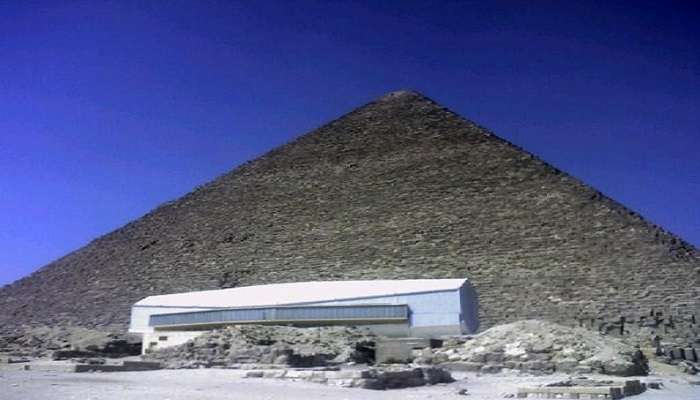
Nestled in the heart of Egypt, Faiyum stands as a testament to the enduring allure of ancient civilisations. This lush oasis, fed by the life-giving waters of the Nile, has been a cradle of human activity for millennia. From its prehistoric roots to its prominence during Pharaonic times and beyond, Faiyum has witnessed the ebb and flow of empires. Today, it captivates visitors who want to explore its archaeological wonders and local culture. This article explores the hidden gems of Faiyum, uncovering the secrets of this fascinating region that continues to intrigue historians, adventurers, and curious travellers alike.
History Of Faiyum
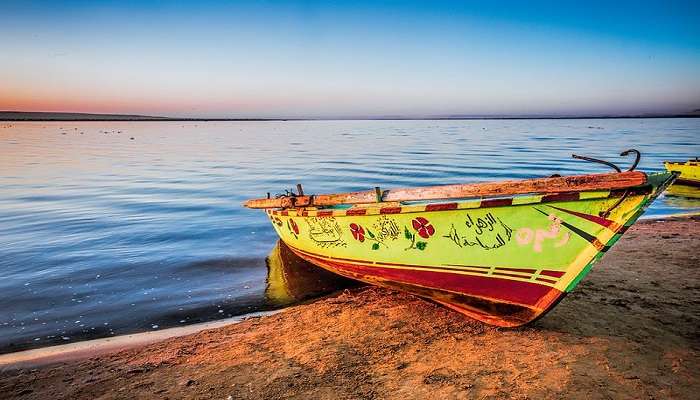
Faiyum, historically known as Crocodilopolis, has a rich and diverse history dating back to the Epipalaeolithic period. Archaeological evidence shows that the area was occupied as early as the Middle Holocene, with significant studies conducted on the north shore of Lake Moeris. The settlement, known as Shedet during the Old Kingdom (c. 2685–2180 BC), was a major centre for the worship of the crocodile god Sobek. The Greeks later called it Crocodilopolis, and it was famous for its sacred crocodile, Petsuchos, which was adorned with gold and gems.
Under the Ptolemaic Kingdom, the city was renamed Arsinoë by Ptolemy II Philadelphus in honour of his sister-wife Arsinoe II. The town was part of the province of Arcadia Aegypti during the Roman Empire and became a diocese with the advent of Christianity. Faiyum was also the seat of Shahralanyozan, governor of Sasanian Egypt, and Saadia Gaon thought of it as the biblical city of Pithom.
The region is famous for the Faiyum mummy portraits painted during the Roman occupation, which show the influence of both Egyptian and Greek art. The Zenon Papyri, found in the early twentieth century, gives a clear account of the social and economic life of 3rd-century BC Philadelphia, with special emphasis on the construction of different public edifices and legal documents. For this reason, Faiyum has such a rich cultural and historical background, with impacts from many different civilisations over thousands of years.
Also Read: Baron Empain Palace
Top 6 Places To Visit In Faiyum
From ancient sites to breathtaking landscapes, here are the top six places to visit in this enchanting destination.
1. Wadi el Rayan

Wadi El Rayan National Park is located in the Faiyum Governorate of Egypt and is a natural wonder with a variety of terrains and several species of fauna and flora. It occupies a total area of 1,759 square kilometres and has two artificial lakes interlinked by the only waterfall in Egypt, which adds to the park’s beauty. Tourists can also enjoy the sulfur springs and the giant sand dunes, which are also features of the park.
Wildlife lovers will find the park particularly interesting as it hosts species such as the slender-horned gazelle and the fennec fox, among others. Bird lovers will have a field day identifying several resident and migratory birds. Also, Wadi El Rayan is important in archaeological aspects, as the Wadi El Hitan area has marine and even ancient whale fossils. Regardless of whether one is interested in nature, wildlife or history, Wadi El Rayan provides a complete package for any interested party.
Location: Al Faiyum Governorate Desert, Faiyum Governorate 2812001, Egypt
Distance From Faiyum: 8.0 Km
Travel Time From Faiyum: 15 minutes
Entry Fees: Egyptian Citizens: EGP 5 per person, Foreigners: EGP 40 per person, Vehicle Entry: EGP 10 for cars
Best Time to Visit: October to April
2. Pyramid Of Amenemhat I
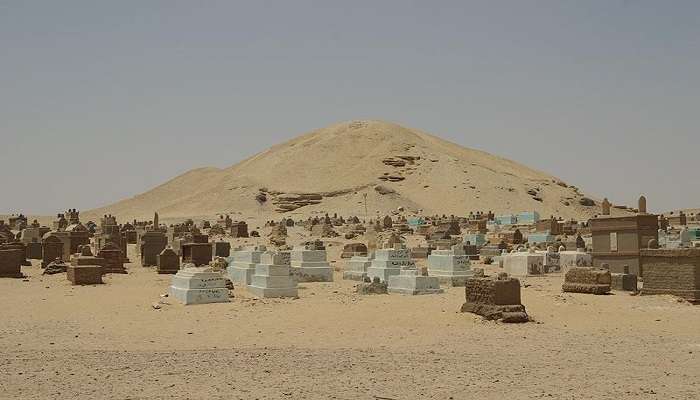
The Pyramid of Amenemhat I is located in Lisht, Egypt. It is famous for the engineering genius of the ancient Egyptians. Amenemhat I, the founder of the Twelfth Dynasty, constructed this magnificent structure during the Middle Kingdom period. The pyramid itself is worth admiring because of its height and the design.
Tourists can walk through the pyramid complex, see the tombs around it, and study the place’s history. The mortuary temple of the pyramid is covered with reliefs and statues and provides insight into the religious culture of the time. For those interested in Egyptian archaeology, the Pyramid of Amenemhat I is one of the places to visit.
Location: H6FG+X4C, Al Lesht, El Ayyat, Giza Governorate 3320022, Egypt
Distance From Faiyum: 62.3 Km
Travel Time From Faiyum: 1 Hour 18 minutes
Entry Fees: Free
Best Time to Visit: October to April
Related Post: Valley Of The Kings
3. Medinet Madi

Medinet Madi is situated in the southwestern part of the Faiyum region of Egypt and is a perfect place to explore the country’s rich history. This was a Greco-Roman town originally named Narmouthis; it was established during the Middle Kingdom, during the time of Amenemhat III and Amenemhat IV. The town’s main attraction is the ancient temple, which is in good condition and devoted to the cobra-goddess Renenutet, the goddess of the harvest.
Visitors to Medinet Madi can also observe the building structure of the temple, appreciate the carvings and inscriptions on the temple’s walls and acquaint themselves with the town’s historical background. Recently, archaeologists discovered the foundations of the temple, the administrative buildings, granaries, and the residential area, which has given historians a glimpse into the life of the ancient Egyptians. Also, visitors can visit other archaeological sites and museums to learn more about the area’s history.
Location: 5JRR+VWP, Monshaat El-Amir, Atsa, Faiyum Governorate 2832597, Egypt
Distance From Faiyum: 30.1 Km
Travel Time From Faiyum: 1 Hour 9 minutes
Entry Fees: Free
Best Time to Visit: October to April
4. Kom Oshim
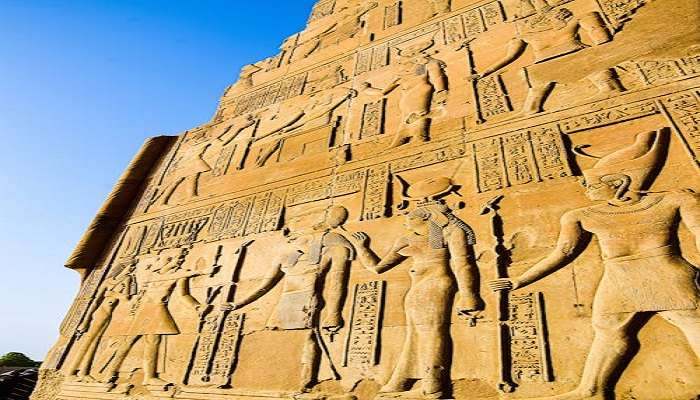
Kom Oshim, nestled in Egypt’s Fayoum Governorate, is a captivating destination rich in history and culture. The Kom Oshim Museum showcases an array of artefacts such as glassware, jewellery, and pottery. Visitors can also marvel at petrified skeletons and enjoy a documentary that delves into the site’s historical significance. This makes it an ideal spot for history enthusiasts and those fascinated by ancient civilisations.
A key attraction is the Kom Oshim Museum, which displays collections from the Prehistoric era to the Greco-Roman period and Coptic and Islamic artefacts. The museum’s highlight is the Fayoum Mummy Portrait of a Man. Visitors can explore the museum and the surrounding archaeological site, making it a must-visit for history enthusiasts and tourists alike.
Location: GV9X+C4F, Faiyum Desert Rd, Al Gemhoureya, Tamiya, Faiyum Governorate 2976008, Egypt
Distance From Faiyum: 26 Km
Travel Time From Faiyum: 40 Min
Entry Fees: Approximately 30 EGP
Best Time to Visit: October to April
Related Post: Hanging Church In Egypt
5. Pyramid Hawara

Located in the Fayum Oasis, Egypt, the Hawara pyramid proves the existence of ancient Egyptian civilisation. This pyramid is one of the most exciting structures of the Middle Kingdom and was constructed by Pharaoh Amenemhat III of the 12th Dynasty. Unlike the previous pyramids, Hawara is a smooth-sided pyramid similar to the Great Pyramid of Giza.
The Pyramid of Hawara is less famous than other pyramids, but it is also interesting to explore the history of ancient Egypt. The architectural design of the pyramid, combined with the peaceful environment, makes it a perfect destination for lovers of history and those who prefer to explore less-known attractions. Visitors can go inside the pyramid, see the rooms which date back to the time of the pharaoh who ordered the pyramid’s construction, and much more.
Location: هوارة المقطع, Hawaret Al Maqtaa, Faiyum, Faiyum Governorate, Egypt
Distance From Faiyum: 10.4 Km
Travel Time From Faiyum: 22 minutes
Entry Fees: 100 EGP
Best Time to Visit: October to April
6. Lahun Pyramid

Image Credit: Einsamer Schütze for Wikimedia Commons
The Lahun Pyramid, or the Pyramid of Senusret II, is one of the most interesting Egyptian pyramids, and it is situated in the Faiyum Oasis. This pyramid was constructed in the Twelfth Dynasty of the Middle Kingdom and is a fine example of ancient Egypt’s architectural and cultural heritage. One of them is the entrance to the burial chamber, located on the south side, while the entrance to the burial chambers of the other pyramids is situated on the north side. The pyramid is constructed of mud bricks, and the inner walls are made of stone to enhance the stability of the structure.
Tourists who visit the Lahun Pyramid can also visit the workers’ village, known as Kahun. This village gives a glimpse of how the working class of ancient Egyptian society lived and supported the pyramid’s construction and the sustenance of the king’s funerary cult. It is an architectural masterpiece and an archaeological site, and therefore, it attracts many history lovers.
Location: 6XPC+G7C, Al Lahoun, Faiyum, Faiyum Governorate 2943740, Egypt
Distance From Faiyum: 23.3 Km
Travel Time From Faiyum: 36 minutes
Entry Fees: 50 EGP
Best Time to Visit: October to April
Related Post: Best Places To Visit In Luxor Egypt
Best Time To Visit
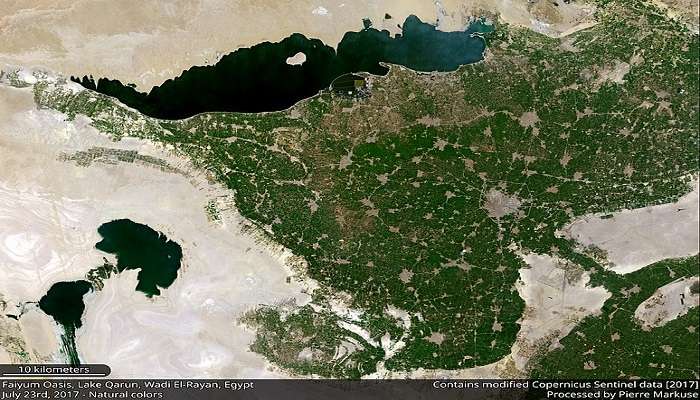
The best time to visit Faiyum is between October and April since the climate is comparatively moderate and favourable. During these winter months, temperatures range from cool to comfortably warm, ideal for outdoor activities like exploring the stunning landscapes, ancient monuments, and lush greenery that Faiyum is known for.
Unlike the intense summer heat, which can be overwhelming, the cooler climate during this period allows visitors to fully enjoy Faiyum’s natural beauty, including the lakes, waterfalls, and archaeological sites. It’s the perfect season for sightseeing and adventures like hiking and bird-watching.
Way To Reach

Faiyum has good transport networks and, therefore, can be accessed through different means of transport. Here are some of the ways to reach the city:
By Road
When coming from Cairo, one can drive through Faiyum Desert Road to Faiyum. The journey typically lasts about 1 hour and 40 minutes. Otherwise, one can hire a bus or a micro-bus from the central bus terminals in Cairo to Faiyum.
By Air
The nearest international airport to Faiyum is Cairo International Airport, which has the code CAI. To get to Faiyum, one has to take a taxi or rent a car from the airport; the distance is about 70km. It usually takes approximately 1 hour to drive from Cairo International Airport to Faiyum, which is 5 to 2 hours.
By Rail
There is no direct rail link between Cairo and Faiyum. But you can get a train to Beni Suef and then take a taxi to Faiyum. The other way is to travel by the Line 1 train to Helwan University and then hire a cab to Faiyum.
You May Also Like To Read: Pyramid Of Djoser
Faiyum is one of the most beautiful sites that are yet to be discovered in Egypt due to its diverse history. It is an ideal place to visit with its ancient temples, pyramids, and the beautiful Qarun Lake. So, if you are thinking about your next trip and are still unsure of the destination, it will be wise to consider Faiyum. Are you prepared to be amazed by the beauty of Faiyum and other wonders of Egypt? This should not be just an adventure in your mind. Don’t wait any longer and start planning your trip to Egypt , a country that holds the magic of ancient times. Get ready to explore history, culture, and the most beautiful scenery that you will ever forget!
For our editorial codes of conduct and copyright disclaimer, please click here.
Cover Image Source: Facebook
Frequently Asked Questions About Faiyum
What is Faiyum famous for?
Faiyum is renowned for its fertility and rich biodiversity, making it an agricultural hub. It is also famous for the Faiyum Portraits, which are exquisite mummy masks that showcase remarkable artistry from the Roman period.
What was found in Faiyum?
Some of the significant archaeological discoveries in Faiyum include the Faiyum Portraits, ancient papyrus fragments containing Greek, Latin, and Egyptian scripts, and a variety of artefacts from early settlements that provide insight into ancient life.
How old is Faiyum Egypt?
Faiyum dates back to at least the fifth millennium BC, with significant settlements established during the Old Kingdom period, around 2685–2180 BC, highlighting its long history of human occupation.
Who discovered Faiyum?
The Faiyum Portraits were discovered by British Egyptologist Flinders Petrie during his excavations in the region around 1898-1899 CE, contributing significantly to our understanding of Roman-era funerary art.
What language is spoken in Faiyum?
The primary language spoken in Faiyum today is Arabic. Historically, the region had a dialect of the Egyptian language known as Fayumic, reflecting its rich linguistic heritage.
People Also Read:

With a passion for travelling, and carving beautiful stories of stunning locations I chose my profession as a content writer. The unique blend of creativity and strategy ensures that each narrative takes readers on a journey to their desired destination. With distinct locations and unique vibes, I strive to deliver captivating content that speaks to the hearts of readers.











